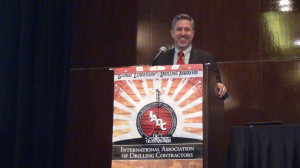To be effective, leaders can’t just ‘wing’ offshore site visits
By Linda Hsieh, managing editor

A guidance document under development at the Center for Offshore Safety (COS) aims to help office-based leadership make the most out of their visits to the worksite and demonstrate visible commitment to safety. The guidelines, which are under final review with a COS committee made up of operators, drilling contractors and service and supply representatives, are expected to be published this year, Alan Quintero, Transocean SVP Americas and a member of the COS Governing Board, said at the 2013 IADC HSE & Training Conference last week in Houston. “To be effective offshore, you can’t just show up and wing it,” he said, adding that preparation is the first of three main sections in the COS Leadership Site Engagement guidelines. Execution and closure are the other two.
“To me, leadership site engagement is avoiding what I call ‘seagull management,’ where you fly in, you leave your droppings on everything, and then fly away. That’s not what you want to do. You want to actually make an impact and walk out of there feeling that the processes, policies and procedures that you’ve put in place as a leader of the company are being followed the way you thought they should be followed,” Mr Quintero said.
While preparing for the site visit, company leaders need to understand what are the current activities going on at the worksite and what are the hazards associated with those activities. “What do you want to evaluate when you’re onboard? Culture? Policies and procedures? Make yourself a plan,” Mr Quintero advised. A sit-down with subject matter experts on the subsea group may be beneficial if you’re going to visit with personnel on the specifics of BOP equipment, for example.
The execution phase of the leadership site engagement needs to start with a thorough site orientation, followed by the company’s safety induction process. “Don’t take shortcuts. You’re leading by example,” Mr Quintero noted. “Your at-risk behavior – like skipping through the safety orientation or not knowing where your lifeboats are – all those types of things get observed by people at the worksite.”
Leaders should also make time for meetings with the site leadership and contractor leaders, where the objectives of the visit should be clearly explained. “Only after everybody is lined up with the plan and what you’re trying to accomplish, then you go and walk around the site,” Mr Quintero said.
After the walkaround, a meeting should be held with your workforce, contractors and especially the site leadership team to share your learnings and to put together a closure plan with follow-up actions. “Show that your meeting was important and you’re following through to provide that level of accountability with the people at the worksite,” he urged.
Mr Quintero also noted that the COS document is meant to be only a guidance to help industry leadership further drive safety processes at worksites; it is not a mandate. “Depending on how mature your systems are, you can pick and choose from it the parts that will help you make your leadership site engagements better.”
The COS expects to provide another update on this guidance document at its first annual forum on 29-30 April in Houston. Click here for more information.




